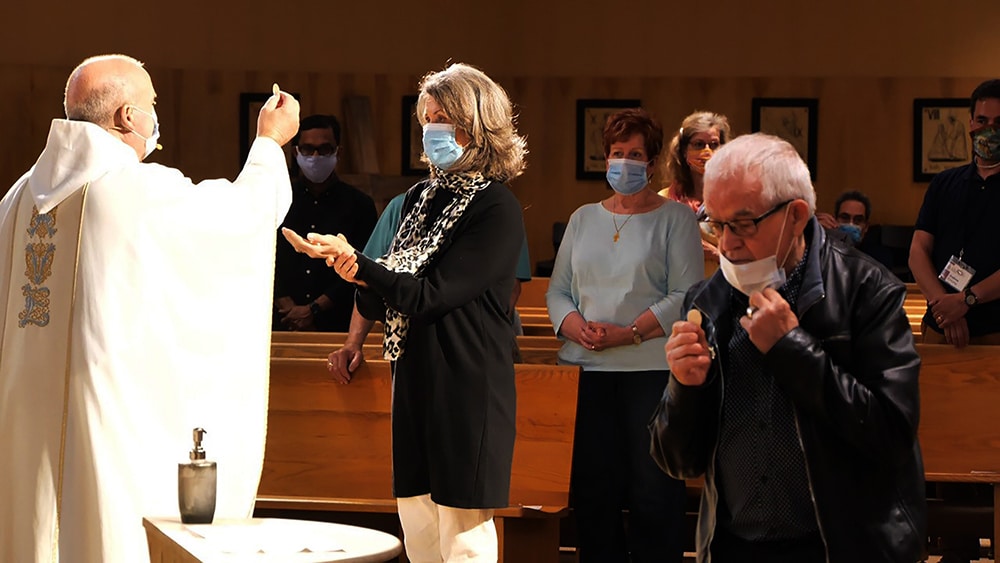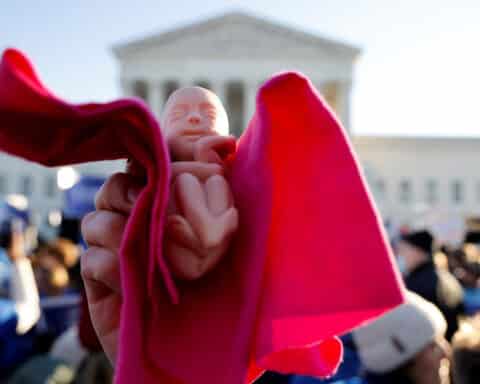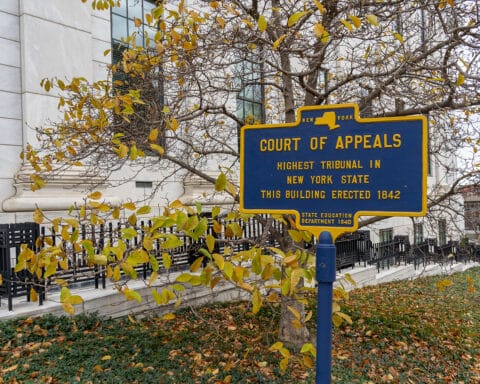
— Sharon Hart, Longmeadow, Massachusetts
Answer: When we receive the Eucharist, we receive the whole Christ: body, blood, soul and divinity. As to his divinity, he has always been glorified. In terms of his humanity, however, after the Resurrection, the body of Christ is glorified. The bodily resurrection of Jesus Christ from the dead does not mean merely that a corpse was resuscitated and restored to its previous condition. Rather, when Christ rose from the dead, he rose clearly in his own body, but dead bodies in a glorified condition can do things that Jesus did not obviously do prior to the Resurrection, except perhaps by miracle. He is able to appear and disappear at will, and he is able to pass through walls and travel at the speed of thought. Also, it is on account of his glorified humanity as well as his divinity that he is able to be in all the tabernacles of the world simultaneously, not to mention that his full presence is in even the smallest fragment of a host or drop of the precious blood. It does not pertain to an unglorified body or humanity to be able to be in all places at once, or to be able to be “subdivided” in separate hosts and places and yet still be undivided truly in himself.
You may recall that when St. Mary Magdalene recognized Christ on the morning of the Resurrection, she clung to him. Christ asked her to step back and take another look, and she saw that something was beautifully different. Mary returned and said to the apostles, “I have seen the Lord.”
So yes, the body and blood and soul that we receive in the holy Eucharist is in fact truly Christ’s humanity, but it is his risen glorified humanity that we receive along with his divinity. One day, too, when our bodies rise, they will be truly our bodies, but gloriously transformed with a far greater perfection than they have now. Hence this is one way in which the Eucharist is a foretaste and pledge of future glory.
Babies in heaven
Question: Do babies who have been aborted go to heaven.
— Jeanie Roch, Cleveland
Answer: It is the general theological consensus that they do go to heaven. There is, however, no defined doctrine on this matter since the Lord has simply not revealed what happens to children who die before baptism. While it is true that Jesus said that no one can enter the kingdom of heaven except through water and the Holy Spirit, he clearly made an exception for the thief on the cross, who had what we call baptism of desire. Second, we know that God is a just God who does not require of people what they cannot reasonably do or know about. Hence, it seems reasonable to conclude that God has special provisions for infants who die before baptism. One can similarly conclude a special mercy that God would justly show to infants who have had their life taken from them so unjustly.
In 2007, the International Theological Commission issued an opinion on this matter, which, while not binding, has high authority:
“It is clear that the traditional teaching on this topic has concentrated on the theory of limbo, understood as a state which includes the souls of infants who die subject to original sin and without baptism, and who, therefore, neither merit the beatific vision, nor yet are subjected to any punishment, because they are not guilty of any personal sin. This theory, elaborated by theologians beginning in the Middle Ages, never entered into the dogmatic definitions of the Magisterium, even if that same Magisterium did at times mention the theory in its ordinary teaching up until the Second Vatican Council. It remains therefore a possible theological hypothesis. However, in the Catechism of the Catholic Church (1992), the theory of limbo is not mentioned. Rather, the Catechism teaches that infants who die without baptism are entrusted by the Church to the mercy of God, as is shown in the specific funeral rite for such children. The principle that God desires the salvation of all people gives rise to the hope that there is a path to salvation for infants who die without baptism (cf. CCC, 1261), and therefore also to the theological desire to find a coherent and logical connection between the diverse affirmations of the Catholic faith: the universal salvific will of God. … The conclusion of this study is that there are theological and liturgical reasons to hope that infants who die without baptism may be saved and brought into eternal happiness, even if there is not an explicit teaching on this question found in Revelation.”
Hence, while this teaching pertains to the wider question of all infants who die before baptism, he can certainly apply also to infants who die so tragically and unjustly through abortion.
Msgr. Charles Pope is the pastor of Holy Comforter-St. Cyprian in Washington, D.C., and writes for the Archdiocese of Washington, D.C. at blog.adw.org. Send questions to msgrpope@osv.com.





